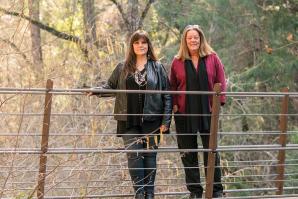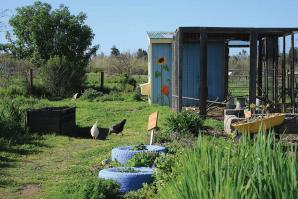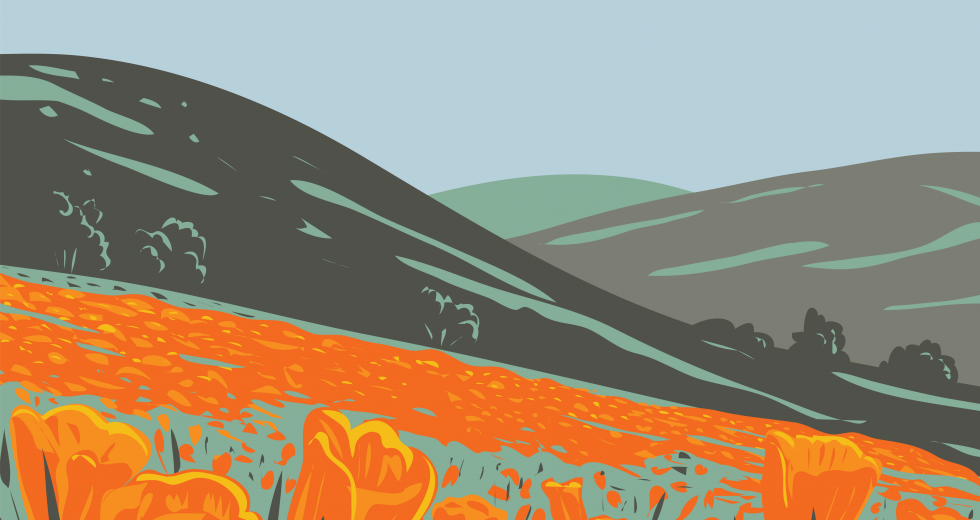It’s late on a Tuesday afternoon in April, and Jennifer Norris, deputy secretary for biodiversity and habitat of the California Natural Resources Agency, is kicking off the first of nine regional workshops that run through mid-May over Zoom to introduce the framework of Gov. Gavin Newsom’s Executive Order N-82-20. The order calls for the conservation of 30 percent of the state’s land and coastal waters by 2030. The workshops hope to gain perspective from stakeholders — all Californians — on how to reach that goal through strategies that are inclusive and represent the interests and needs of all communities.
California’s impressive landscape was shaped by earthquakes and volcanoes millions of years ago. Combined with its mild, Mediterranean climate, California became a haven of diverse habitats. Forests, deserts, chaparral, shrubland, woodlands, salt marshes and coastal dunes support such a rich diversity of plants and animals — many of which only exist in California — that the Golden State is one of the most biologically diverse regions on Earth.
It’s also home to one of 36 global biodiversity hotspots. Of the regions with the greatest biological diversity, hotspots are those that have also lost more than 70 percent of their native vegetation, typically due to human activity. California’s hotspot, the California Floristic Province, retains only a quarter of its original vegetation in relatively pristine condition, according to the Critical Ecosystem Partnership Fund, a joint initiative between international governments and environmental organizations such as Conservation International, which researches and works to protect biological hotspots.
But why does protecting plants and animals matter? Norris explains it this way: “You don’t have ecosystems without species.” Soil without organic matter and organisms is just rocks. Or the ocean is just a bunch of salty water unless there are plankton and kelp to process the oxygen we breathe, she says. “People … see animals and plants as beautiful things we look at. But in fact, they’re essential building blocks of making these ecosystems work.”
Newsom’s 30 by 30 order — which aligns with the United Nations’ international and President Joe Biden’s nationwide goals for biodiversity — builds upon Gov. Jerry Brown’s 2018 executive order to address the threatened state of California’s biodiversity and the mounting impacts of climate change, shifting our approach away from reactionary conservation in response to individually threatened or endangered species and toward proactive conservation of entire ecosystems. And it charges CNRA to lead the efforts and submit long-term strategies by February 2022.
The order’s framework seeks to preserve or restore biological diversity and intact habitat, and use nature-based solutions — land management practices such as carbon sequestration, healthy soils and greening urban spaces that address environmental, social and economic challenges — to combat climate change, which is unraveling the Earth’s ecosystems.
And it calls for action “in ways that serve all communities and in particular low-income, disadvantaged and vulnerable communities” and provides equitable access to the outdoors for all Californians. All while safeguarding the state’s economy — the fifth largest in the world — fueled by industries that depend on the very health of our natural resources such as agriculture, timber production, tourism and recreation.
What counts as conservation toward the 30 by 30 goal has not yet been defined by CNRA, but one analysis by the Center for American Progress of the U.S. Geological Survey’s Protected Areas database estimates 22 percent of California’s 104 million acres of land is conserved and 16 percent of its 3.13 million acres of coastal waters is conserved. To reach the goal, land conservation may occur through restoration, land acquisition and conservation easements on private property, as well as changes in land management.
In addition, the executive order identifies natural and working lands, such as forests, rangeland, wetlands and farms, as an integral component of habitat conservation and carbon sequestration, which helps slow the rate of a warming climate by retaining carbon in the soil. There are more than 34 million acres of agricultural land in California, and another 45 percent of California’s land — including national parks, forests, rangeland and land leased for oil and natural gas production — is owned and managed by the federal government, which will play a key role toward the conservation goal.
Initial strategies to conserve coastal waters will not include an expansion of the state’s 124 marine protected areas. However, an expansion or reconfiguration of those areas could take place once a joint-agency, decadal review of the Marine Life Protection Act is completed by the end of 2022, says Mark Gold, executive director of Ocean Protection Council and deputy secretary for ocean and coastal policy for CNRA.
Additionally, Gold says stakeholder engagement will be critical to define what conservation of coastal waters means. That effort could mean greater protections for some of the state’s 34 areas of special biological significance in coastal waters, as well as national marine sanctuaries, estuarine research reserves and estuary programs, which could help the state reach 30 by 30.
An Inclusive Conversation
As part of Newsom’s executive order, he directed the formation of a California Biodiversity Collaborative to solicit feedback from a diversity of voices to determine what will be conserved and how. “It’s working with as many different partners as possible to say, how can we join forces and make sure effective conservation happens?” Norris says.
The California Biodiversity Council, established in 1991 to align coordination and cooperation between government agencies, is part of the collaborative. While it has not yet been established how the council will function differently than it has in the past, Norris says there’s energy and excitement among agencies within the council. “(It) is very explicitly focused on bringing together federal, state and local governments to say, what are the opportunities to join forces?” she says. “I think it is identifying their policies, their upcoming opportunities, their priorities within each agency … and seeing where we have common ground and how we can leverage those together, whether it’s funding, policy changes or what have you.”
Most recently, the California Biodiversity Network was formalized, bringing together environmental experts and leaders in conservation across academic, educational, scientific, governmental and tribal communities that will look to unify efforts and projects statewide. “Those are the real practitioners … that are doing constant biodiversity conservation, in particular diversity research. … (They’re) less visible but foundational to our success moving forward,” Norris says.
Beyond inclusion in the California Biodiversity Collaborative, CNRA is formally engaging Native American tribes through government-to-government consultations, which began in January 2021 and will extend through December 2022, to learn from their unrivaled working knowledge of the natural world and preserve and protect culturally sensitive areas and practices.
Native Americans were the earliest ecologists who understood how to balance the needs of people with the needs of the Earth. But when European settlers came to California, spurred by the promise of prosperity and wealth, livestock grazing, hunting, the fur trade, and the gold rush decimated the natural world and the Indigenous population and set a precedent for how the state’s resources would be used to advance human civilization.
“People really see themselves as part of this conservation story and want to engage. We need to listen to people (who) do this every day and understand what those challenges are and how we can work together to really make this successful.”
Jennifer Norris Deputy secretary for biodiversity and habitat California Natural Resources Agency
Norris says there’s been an incredible amount of interest and requests for conversations since the executive order was signed. In the last six months, she’s met with diverse stakeholders including farmers, ranchers, cattlemen, foresters, environmental equity groups, representatives of ports and water interests, people interested in wilderness and roadless areas, environmental education groups, and local and regional parks staff. “People really see themselves as part of this conservation story and want to engage,” she says. “We need to listen to people (who) do this every day and understand what those challenges are and how we can work together to really make this successful.”
More than 300 people joined the inaugural virtual workshop in April that focused on the Sacramento Valley. Efforts to make the workshops inclusive included translation in Spanish, Mandarin, Cantonese and Vietnamese, and technical assistance was available for those who don’t have internet access but do have a phone. In one of three breakout groups, of those who replied to the real-time survey, government and community-based organizations made up 80 percent of participants, followed by the business industry, then the general public and academia, and less than 1 percent represented tribal governments or communities.
CNRA has reached out to several representatives of underserved communities statewide, including California Environmental Justice Alliance, an Oakland-based statewide coalition that advances environmental justice through policy solutions. CNRA will also host one of several topical workshops dedicated to equity to elevate the distinct voices of underserved communities, which are often left out of the conversation on land use and carry the burden of environmental inequity.
While Tiffany Eng, green zones program manager of CEJA, is not involved in the state’s 30 by 30 efforts, she speaks to the inherent value of including underserved communities in those conversations. Meaningful engagement with underserved communities means doing the due diligence around education and outreach in the same way it’s done for scientific research, so decision-makers include the perspectives of frontline community members before final decisions are made, Eng says. “This is critical for democracy. It’s a cornerstone of what we say that we’re supposed to be about in this country.”
Community members have an intimate working knowledge of their neighborhoods that may not appear in scientific data or theory, she says. There are cultural sensitivities, unique community dynamics, a host of challenges communities face and patterns of how community members engage within their neighborhoods that should be included in decisions.
“I think there’s this assumption that local government knows best and I think that what we’re trying to say is that there’s actually many different kinds of expertise and competence,” says Eng, who advocates for building community engagement into budgets. “I think that there’s a lot of people who say well, we don’t have the money for that, but really what I hear is that you don’t have the political will.”
A Statewide Vision of Conservation
CNRA is still in the information-gathering stages of how to reach a statewide vision of conservation. Drafts of the natural and working lands and climate smart strategies, and the pathways to reach 30 by 30 won’t be released until this summer and fall, respectively. But Norris points to the Yolo Habitat Conservancy and the South Sacramento Habitat Conservation Plan, two local efforts in the Sacramento Valley that marry some of the best strategies CNRA wants to scale across the state, which simultaneously address conservation and economic development on a regional scale.
“SSHCP is designed to protect the beautiful agricultural landscape of South Sacramento and the vernal pool grasslands but also facilitate transportation, a big new connector from (Highway) 50 to (Interstate) 99, and lots of development along the 50 corridor (while) protecting habitat very aggressively,” Norris says. “They’re living that story.”
The 317,000-acre plan in South Sacramento designates more than 36,000 acres of connected, conserved land outside the urban development area over the next 50 years, protecting 28 sensitive plant and animal species and their habitats. SSHCP is the first habitat conservation plan in the nation to streamline Clean Water Act and Endangered Species Act permits for development at the county level, but it took 24 years to move the SSHCP from idea to completion in the summer of 2019.
“We mostly failed in five-year increments.”
Bob Shattuck president, Shattuck Planning and Management
“We mostly failed in five-year increments,” says Bob Shattuck, president of Shattuck Planning and Management, who represents the business community under the SSHCP. There was broad agreement among agencies, developers, the environmental community and the agriculture industry that there was a better way to coordinate local planning with state and federal environmental regulations, says Shattuck, but it was “a tangle of overlapping, competing and oftentimes conflicting regulations, all of which were developed for specific purposes … but when you combine them all, it’s almost impossible to map it out. … There was no coherent overall plan, and the result was just really inefficient in terms of both conservation and economics.”
Negotiations to develop the plan replaced CWA and ESA regulatory nightmares, as well as lawsuits by environmental groups against developers that often stalled projects for years, and provided predictable, streamlined processes and costs. “That just makes it a lot easier to respond to market demand in a timely fashion. I think it’s one of the biggest issues we’ve had over the years that helped lead to the housing shortage,” says Shattuck.
And environmental groups replaced “postage-stamp size parcels” of land — some that were poor-quality habitat — that passed as mitigation but were not part of the connected landscape and wouldn’t provide long-term sustainability. Instead, the plan approaches mitigation with a regional strategy that conserves thousands of interconnected acres of the best quality habitat, says Sean Wirth, conservation chair for the Mother Lode Chapter of the Sierra Club and a representative of the environmental community under the SSHCP.
But while SSHCP is an excellent example of how the state could approach the coordination of conservation and economic growth and development to help reach 30 by 30, it also illustrates some of the challenges it could face with land acquisition as it scales efforts statewide.
Wirth says the SSHCP is a much smarter plan but “it’s not going to do it. It’s not even close to going to get it done, but it does very nicely offset the negative aspects of all the new urbanization that’s going to happen. And it does it in a very intelligent, regional context. … But it’s not enough. We never thought it would be enough. This was just one of the things we were working on to help address the problem.” He adds that some say the SSHCP takes care of all our regional habitat needs. “I always remind them that is a very inaccurate perspective to start with. It’s not even close to true.”
And executing a habitat conservation plan can have its unknowns. The majority of land designated as conserved in the SSHCP is privately owned, and Wirth estimates less than a couple thousand acres have been purchased so far. He says securing the land needed to meet the conservation target could be tricky in several of the plan’s eight preserve planning units. In one of those units, securing the commitments needed from private landowners could be difficult, and in several others securing the funds needed to purchase property with quality vernal pools before they degrade due to lack of management could also be problematic.
Funding the purchase of mandatory habitat will come from development project fees within the SSHCP, which is dependent upon the economic ups and downs of the real estate market, says Wirth. When the market is booming, funds are available to purchase land from development fees, but the cost of land also increases. But when the market experiences a downturn, and development and fees to acquire important habitat slows, Wirth sees an opportunity.
He envisions a state or federal program that either provides low-interest funds for HCPs to acquire important habitat or purchase the land when funds are not available from development fees. During an economic downturn, the government could secure low-cost loans and land would be inexpensive. When the economy trends upward and development begins to generate fees again, HCPs could purchase the land from the government at the current market rate, reimbursing the government all its expenses to purchase the habitat.
“It would be one extra little piece that allows habitat conservation plans to always be able to get the best habitats when they’re available, irrespective of having any funds available, and that’s something that is completely doable. It’s just a matter of getting the right people together to make it happen,” says Wirth. “Thirty-by-30 really brings it to the fore because we need to throw everything we have (at it) to be able to meet that goal.”
–
Stay up to date on business in the Capital Region: Subscribe to the Comstock’s newsletter today.
Recommended For You

Young Climate Activists March 266 Miles in Support of Green Jobs Legislation
Eight marchers crossed the Tower Bridge June 4 to join a rally in
support of a bill aimed at creating 1.5 million jobs in areas
such as clean energy, climate resilience and environmental
remediation.

Greener Pastures
Long Dream Farm aims to prove that dairy production can be both ethical and economically viable
Andrew and Krista Abrahams want to rethink the assumptions of traditional dairy production.

A Tarnished Past
How stakeholders in the Sierra Nevada are confronting the lasting legacy of the gold rush
Over the past two decades, a coordinated effort focused on science and policy, education and awareness, and an entrepreneurial approach to workforce development has been underway to come to grips with the lasting legacy of the mining age.

Regenerating Our Soil
A shift in agriculture practices can help the environment — and the bottom line
The dialogue around regenerative agriculture has evolved over the last decade as agricultural methods that were once practiced by Indigenous communities around the world are reemerging.





Comments
Outstanding!